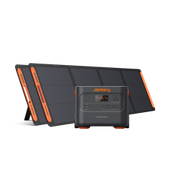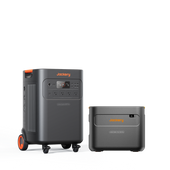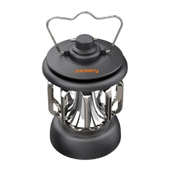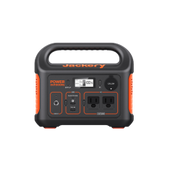Staying safe during a tornado is crucial, especially as tornado activity increases. The NOAA has issued multiple warnings for tornadoes to hit the coastal areas in mid-July 2024. Tornadoes pose significant risks, from property damage to life-threatening situations. Understanding how to keep safe in a tornado can make a critical difference to life and property.
Staying safe during tornadoes is one thing, but it's also important to ensure that you have all the essential items with you. Most regions face frequent power cuts during tornadoes, and in such scenarios, having a Jackery Solar Generator is highly recommended. The portable solar generator can charge 99% of your household appliances and ensure that your entire family stays safe and protected during the tornado outbreak.
Key Takeaways
In the comprehensive guide to understand how to keep safe in a tornado, we are going to analyze different aspects that will not only keep you safe during a tornado but will help you understand how to ensure you have the essentials to keep you protected. Some other important areas that we are going to discuss are:
- The basic hazard risks of tornadoes
- Understanding tornado warnings and emergency alerts
- Different ways to keep safe during a tornado
- Tips and tricks to keep your child safe during a tornado
- And Jackery Solar Generators help you power your household appliances during extended power cuts.
100+ Tornado Warnings in Monroe, Ontario, & More
As of July 2024, Hurricane Beryl has already created havoc in the Southeast parts of the United States. Hurricane Beryl's passage through upstate New York has led to multiple tornado warnings issued by the National Weather Service (NWS). The remnants of Beryl brought severe thunderstorms capable of producing tornadoes, which are reportedly going to affect several major areas like Monroe, Ontario, Wayne, and Genesee counties.
According to USA Today, Tornado activities were even detected near Palmyra, Webster, and Honeoye, and it is stated that the tornadoes are moving northeast at significant speeds. The NWS has also confirmed tornado sightings and issued warnings to alert residents of the potential for roof, vehicle, and window damage.
Hazard Risks of Tornadoes
Tornadoes are among the most destructive natural disasters. They can cause extensive damage and pose significant risks to life and property. These violent storms can destroy homes, uproot trees, and hurl debris violently.
As you can see from the reports, the US experienced an above-average number of tornadoes in 2023. These outbreaks included significant events such as the EF-1 tornado in Los Angeles, the EF-4 and multiple EF-3 tornadoes in March, and the record-setting EF-3 tornado in Delaware. There are several notable hazard risks involved in tornadoes, which include:
Structural Damage
Tornadoes can demolish buildings, strip roofs, and tear down walls, leading to massive property losses. To put things in perspective, the EF-4 tornado in Adair County, Iowa, in May 2024 caused widespread destruction in several parts, including Greenfield. According to the National Weather Service, the EF-4 tornado had winds between 175 - 185 mph.
Flying Debris
High winds turn everyday objects into dangerous projectiles. For instance, during tornadoes, it is often noted that the aluminum and steel shades can cause injuries and fatalities. In March 2023's EF-4 tornado in Mississippi demolished several homes and left piles of debris on concrete slaves and debarked trees. Such rare tornadoes result in significant debris-related hazards across multiple cities.

Power Outages
Tornadoes often disrupt power lines, resulting in extended outages. For example, the tornado outbreak of April 26 - 28, 2024, is considered one of the deadliest, as it caused widespread damage near Bennington and Blair. Due to the tornado warnings and the rise of I-35 near the Texas border, several households had to face power cuts due to downed power lines and overturned vehicles.
According to multiple news portals, more than 29,000 power outages occurred in Texas and nearly 11,000 in Nebraska.
Flooding
Heavy rainfalls are often associated with tornadoes, which can lead to flash flooding. So, tornadoes damage livelihoods and initiate other natural disasters that increase the havoc.
On March 31, 2023, a Tornado outbreak began across portions of the lower Mississippi River Valley in the United States, putting 28 million people under tornado watches. This outbreak brought heavy rains and caused widespread flooding in the affected areas. Such tornado trends have continued into 2024, with severe outbreaks causing widespread devastation.
Understand Tornado Alerts
Tornado alerts are critical for ensuring safety during severe weather events. The National Weather Service issues three key alerts: Tornado Watch, Tornado Warning, and Tornado Emergency. When one can recognize the difference between these alerts, they can respond appropriately and follow the guidelines.
The tornado alerts help the public take necessary precautions, stay informed before the tornado, and prepare themselves to take immediate shelter when it has caused catastrophic damage.
Tornado Watch: Be Prepared!
When the government issues ‘Tornado Watch' alerts, it means that tornadoes are possible in and near the watch area. When this alert is issued, it is recommended that you review and discuss your emergency plans, take inventory of your supplies, and check your safe room. Such tornado watches are crucial as they can cover large areas and last for several hours.
Tornado Warning: Take Action!
When the officials issue a 'Tornado Warning' alert, it means that a tornado has been sighted or indicated by weather radar. According to this warning alert, there will be an imminent danger to life and property, and moving to an interior room on the lowest floor of a sturdy building is advisable. For example, the EF-4 tornado warning in Greenfield, Iowa, saved lives as the residents were already warned and they had taken all the immediate actions.
Tornado Emergency: Seek Shelter Immediately!
When the government issues a 'Tornado Emergency' alert, it means that a violent tornado has touched down. This is considered the highest alert level, and residents are warned that this tornado is a severe threat to human life and property, with catastrophic damage confirmed. In April 2024, the government declared several tornado emergencies, emphasizing the extreme danger.
What to Do During a Tornado Watch:
There are a handful of things that one should do when the government issues a tornado watch in their city or county, like:
- Monitor local news to stay informed on weather updates.
- Ensure that your emergency kit is stocked and you have ample amounts of food, water, and medications,
- Map out the nearest shelter and conduct a drill on how to get there quickly.
- Use Jackery Solar Generator to power up your emergency appliances.
What to Do During a Tornado Emergency:
Now, when the government has issued a tornado emergency, there are a few quick actions that you need to do, like:
- Immediately seek shelter in a basement or an interior room with no windows.
- Make sure that your family, including elders and pets, are protected under heavy blankets.
- Try to avoid shelters in cars or mobile homes.
- Keep your mobile phone and emergency lights within reach.
- Stay tuned to local weather updates and only come out of the basement when authorities declare it is safe.
How to Keep Safe in A Tornado
Tornadoes are powerful and unpredictable, but with the right preparation and knowledge, you can increase your chances of staying safe. Staying safe during a tornado requires preparation, awareness, and prompt action by the community. Tornadoes can strike with little warning, so it is crucial to have a plan in place. Government officials have issued multiple safety guides that help residents stay safe during a tornado.
Some of the most common steps to ensure your safety before, during, and after a tornado are:
Prevention & Practice
Like most emergency conditions, precaution is better than cure! Similarly, having a thorough understanding and availability of essentials is key to tornado safety. When facing a tornado, it is recommended that you develop a comprehensive emergency plan that includes designated safe areas in your home.
If you are still wondering how to keep safe in a tornado, you can plan out a basement or an interior room without any windows. During the tornado watch alerts, you can conduct drills with your family to ensure everyone knows what to do and where to go during a tornado. Such prevention methods and regular practices ensure that your home and all the residents can withstand tornadoes.
Know the Signs & Warnings
Being able to recognize the signs of an impending tornado is crucial. Make a habit of following the weather updates, but also trust your instincts. Always look out for dark, greenish skies, large hail, a loud roar from the clouds, and an approaching cloud of debris.
By familiarizing yourself with different alerts (Tornado Watch, Tornado Warning, and Tornado Emergency), you can ensure the safety of everyone in the house or in your community.
Stay Informed
Use NOAA Weather Radio, which provides continuous updates and tornado-related alerts. You can further monitor local news and weather apps on your smartphone to stay well-informed about any signs of weather changes. If there are news or alerts from your electricity providers that there will be a power cut during the tornado, ensure that you have a reliable power source like a Jackery Solar Generator that can keep your emergency devices charged.
Evacuate Safely
It is not recommended to stay in a mobile home or vehicle at the time of tornado alert. But if, for some reason, you are in such a condition, try to evacuate yourself and your family to a sturdy building. However, before leaving your vehicle, make sure that you have turned off the engine; otherwise, there will be other vehicle-related issues that you might have to face once the tornado has passed.
Emergency Supplies
Every family should have an emergency supply ready. Whether it's a hurricane, extended power outages, or tornadoes, an emergency kit with essential supplies such as water, non-perishable food, medications, first-aid supplies, flashlights, batteries, and important documents comes in very handy.
Power outages are very common during tornadoes, and there is always some sort of reliance on electricity. In such conditions, having a Jackery Solar Generator can be invaluable as it can help you power sump pumps, GPS devices, portable medical ventilators, televisions, etc.
Wear a Helmet or Extra Protection
Wearing a helmet can significantly reduce the risk of head injuries caused by flying debris. If you or your family need to travel from one place to another, try covering your head with a helmet. In case you don't have helmets or similar sturdy head protection gear, you can also use heavy blankets or mattresses. Additionally, you can even go ahead with night goggles and sturdy shoes that will provide good visibility during tornado outbreaks.

Where to Take Shelter in A Tornado
Knowing where to take shelter during a tornado can significantly increase your chances of survival. This helps you stay safe during tornadoes and ensures that your belongings are protected as much as possible. That said, finding the right shelter during a tornado is critical, and if you look for it, you might risk your life.
So, it is highly recommended to make a note of the places where you can take shelter during a tornado. Some of the most common and accessible places are:
At Home
- Basement:The basement area of your home or office compound is one of the safest places to be during a tornado or other natural disaster, except for earthquakes. Try to take cover under a sturdy table or workbench to protect yourself from falling debris.
- Interior Room:According to the CDC, if you don't have a basement, you can always choose an interior room on the lowest floor of your home or office without any windows. In rare cases, if you don't have such accessibility, you can also opt for staying in the bathroom or closet area.
- Protective Cover:During tornadoes, try using mattresses, heavy blankets, or pillows to shield yourself from debris. If a helmet is easily accessible, try wearing one.
In Office
- Interior Hallways:If you are in the office, try moving to an interior hallway on the lowest floor. Ensure that you and your co-workers avoid windows and large open spaces such as auditoriums and cafeterias.
- Under Sturdy Furniture:To protect yourself from debris, try taking cover under sturdy furniture, such as desks or tables. That said, make sure that there are not too many electronics on the table, as there is always the risk of fire.
- Emergency Plan:Every office has an emergency plan stating what to do during emergencies. Always follow the office's emergency plan and listen to the instructions of safety personnel. For instance, it is not advisable to use elevators as there is always a risk of a power outage and getting stuck inside for long durations.
In a Mobile Home
- Evacuate: NOAA does not not recommend staying inside mobile homes during tornadoes. When you find yourself in such an emergency, evacuate immediately to a nearby sturdy building or storm shelter.
- Community Shelter:If your community has a designated storm shelter, take your family, pets, and essentials as soon as a tornado watch is issued.
At School
- Designated Shelters:Most community or public schools usually have designated tornado shelters. During the tornado watch alerts, move quickly to these areas.
- Duck and Cover:Get into the "duck and cover" position, which requires kneeling down, head to knees, covering the head with your hands, and staying low to the ground.

In a Car
- Seek Shelter:Similarly to a mobile home, staying in a car during a tornado warning is not recommended. But if you are in a car, drive to the nearest sturdy building or storm shelter, park the vehicle in the open, and go inside the building.
- Out in the Open:If you can't reach shelter in major emergencies, get out of the car and find a low-lying area such as a ditch. Lie down and cover your head with your hands. Make sure that you are not in the vicinity of large trees or electric poles.
- Stay Low:If you are in the open, then do not seek shelter under an overpass or bridge, as these can create wind tunnels and increase danger.
In the Open Outdoors
- Find a Low Spot:If you are caught outside with no shelter in sight, find a low-lying area such as a ditch or depression where you can lay low till it becomes easier for you to move to a better shelter area.
- Lie Flat:Lie flat on the ground and cover your head with your hands, as it may protect you from the tornado and debris. That said, be aware of potential flooding in low-lying areas, as staying in that area can be dangerous.
In Public Spaces
- Shopping Malls, Churches, Theaters:If you are outdoors during the tornado, move to interior hallways or windowless rooms of shopping malls or churches. Always avoid large open areas with wide-span roofs, as they may shatter during heavy wind or rainfall.
- Follow Instructions:When you are inside a shopping mall or theater area, follow the instructions of building staff or emergency personnel. The staff in charge are properly trained and know their way in and around the building. They may require you to follow specific tornado safety procedures.

How to Keep A Baby Safe in A Tornado
Protecting your baby or children under the age of ten during a tornado requires preparation and awareness. For starters, you can have an emergency kit ready or assign a room that one can use at the time of such emergencies. Moreover, you can use a baby carrier, get yourself updated, and even practice emergency drills that can significantly increase your baby's safety during a tornado.
Prepare an Emergency Kit
When you are making an emergency kit for yourself or your partner, try making a separate one for your baby. A baby's or an infant's emergency kit will include diapers, formula, bottles, baby food, and a change of clothes.
In most cases, you can also include your baby's favorite toys or blankets to help them soothe during a stressful environment. You can further use the Jackery Solar Generator to keep baby monitors and other essential devices fully charged during power outages.
Designate a Safe Room
If you live in a tornado-prone region, then always designate a safe room where you can take shelter during a tornado. Such designated areas can be a basement or an interior room with no windows or ventilation. When you enter the designated area, ensure you carry the emergency kit for yourself and your baby, including mobile phones, diapers, medicines, portable power stations, and flashlights.
Use a Baby Carrier
There are economical baby carriers available in the market that can help you securely hold your baby. With the help of a baby carrier, you will not have to hold on to your baby, leaving your hands free to protect yourself and manage other tasks. Such baby carriers are especially useful if you are a single parent and have other important tasks to manage during a tornado outbreak.
Stay Informed
You can download reliable weather mobile applications or get a NOAA Weather Radio that provides timely weather alerts or notifications. To ensure that your emergency electronics are fully charged, you can use Jackery Solar Generators.
Additionally, you can contact the nearby shelters and ask if they are providing special services to children below the age of ten. With such communities, you can ensure that your child will have a familiar atmosphere and stay calm.
Practice Emergency Drills
Regularly practice emergency drills with your family, including quickly and safely moving to your designated shelter area. Always inform everyone in the home about the specific actions they need to take to keep the baby safe during these drills.
Jackery Solar Generators Explained
Jackery is an award-winning manufacturer of solar generators, portable power stations, and solar panels. For its wide range of solar generators, Jackery has received numerous accolades and has been featured in notable media houses for its research and development in the field of solar energy.
A Jackery Solar Generator is a portable unit with a high-capacity battery, ideal for charging 99% of household appliances, such as televisions, refrigerators, sump pumps, baby monitoring devices, and more. Jackery Solar Generators are ideal during tornadoes as they are lightweight and easy to carry. So, if you are moving to a community shelter, you can easily carry it along with you.
Jackery Solar Generators can be charged using the Jackery SolarSaga Solar Panels. These solar panels feature a honeycomb design and monocrystalline cells to harness the maximum light. When connected alongside the Jackery Portable Power Stations, these solar panels transfer the electricity, which is then converted into usable AC electricity.
There are a handful of Jackery Solar Generators that you can use for emergency conditions, but if you are especially looking for tornadoes or extended blackouts, you can check out a few of the best-selling solar generators:
Jackery Solar Generator 3000 Pro
The Jackery Solar Generator 3000 Pro is an ideal solar generator for those looking to power mid to large-capacity appliances during power outages or tornado warnings. Its high-capacity battery can provide power to most major appliances, such as an air conditioner, refrigerators, televisions, and other emergency gadgets.
Appliance Working Hours 3024Wh
- Air Conditioner (1500W): 1.7H
- Coffee Maker (1000W): 2.5H
- Refrigerator (800W): 3.2H
- TV (150W): 17.1H
- Laptop (120W): 21.4H

Customer Review
"Sent right away. Works great so far with a home charge and solar charge. Will be hooking it up to my pop-up camper next week. Great size, quiet, and good app so far." -- James Matthews.
Jackery Solar Generator 2000 Plus
With easy setup, 20ms of emergency power supply time, and ultra-long standby time, Jackery Solar Generator 2000 Plus is an ideal companion during tornadoes. You can easily carry this solar generator to your basement or designated area, connect it with the major appliances, and it will automatically start powering them as soon as the power cut happens.
Appliance Working Hours 2042.8Wh
- Small Air Conditioner (1500W): 1.1H
- Blender (1000W): 1.7H
- Band Saw (900W): 1.9H
- Leaf Blower Charger (800W): 2.1H
- Electric Skillet (500W): 3.4H

Customer Review
"Recently purchased the Jackery 2000 plus. The product arrived very promptly and actually surprisingly fast. Despite there being a road-closing snowstorm causing a day delay. Works as it should, very pleased." -- Seth Connell.
Jackery Solar Generator 1000 Plus
The Jackery Solar Generator 1000 Plus comes with industry-leading features and can effectively power a coffee maker, car fridge, small projectors, portable air conditioner, and more. What sets Jackery Solar Generator 1000 Plus apart from its counterparts is the fact that it supports up to 3 add-on battery packs, which expand its battery capacity to 5kWh. This ensures that your entire home will stay powered up for almost three days during the tornado.
Appliance Working Hours:
- Deep Freezer (700W): 1.8H
- Flood Lamp (500W): 2.5H
- Central Heating Pump (300W): 4.2H
- Slow Cooker (200W): 6.3H
- Radio (60W): 21.0H

Customer Review
"Not only great for appliances that require more than 1000w, it's also great for smaller needs. We recently took it with us on a trip and used it for an electric blanket to get through the cold nights." -- Casey Tuohy.
How to Keep Safe After a Tornado
The aftermath of a tornado can be chaotic and dangerous. If you are someone who had to walk out of your house and take shelter in the community center, then going back to your home can also be emotionally draining. When going back home, try to avoid structural and electrical hazards. You can also wear protective gear and seek support from the experts to navigate the aftermath safely.
Here are a couple of quick tips to consider while keeping yourself safe after a tornado:
Check for Injuries
First, check yourself and then start checking others. Take out the first aid kit from your emergency kit and seek medical attention if needed. You can even avoid moving severely injured people. In such cases, you should wait for emergency responders.
Safety Hazards
Try to stay away from the damaged buildings as there is a huge possibility that they may collapse. If you find such buildings in your vicinity, then you should report the damage to the authorities to avoid further loss of life. At the same time, watch out for the downed power lines and avoid puddles with wires.

Utility Safety
If you smell gas in your house, open all the windows and leave the area immediately. In similar cases, you should contact the authorities, who will help you out. Moreover, try avoiding the use of tap water until the authorities confirm it is safe to use it. Until then, you can use bottled water for drinking and cooking.
Seek Mental Support
Traumatic events can damage mental health. After the tornado, it is advisable to talk to friends, family, or mental health professionals to process the overall experience. Another important thing is to re-establish routines and engage in self-care activities to help restore a sense of normalcy.
Tornado FAQs
What size of solar generator do I need for an emergency?
The exact size of solar generator that you will require in an emergency situation like a tornado depends on multiple factors. Even a Jackery Solar Generator 300 Plus is sufficient if you live alone and have limited appliances. However, if you want to use the solar generator as your main power source during a power outage, you may require a high-capacity solar generator.
Let's consider a scenario where you are using a Jackery Solar Generator 3000 Pro to power up your emergency appliances during a tornado. Suppose you aim to use a portable refrigerator (800W) and one LED light (5W) simultaneously. Then, the working hours that you will get with this solar generator can be calculated with the following formula:
Working Hours = Battery Capacity in Wh * 0.85 / Wattage Consumption of the Appliances
Working Hours = 3024Wh * 0.85/805W = 3.19H
Note: The battery capacity is multiplied by 0.85 to account for the power loss during initial charging.
What should you never do during a tornado?
Never stay in a mobile home or a car during a tornado. Also, try avoiding large open spaces such as auditoriums or gymnasiums. Moreover, do not attempt to outrun a tornado in your vehicle; instead, seek shelter in a sturdy building.
What are 5 survival tips for tornadoes?
The major survival tips for a tornado are:
- Always have a tornado emergency plan and practice it.
- All the family members should know the signs of a tornado.
- Make sure you designate a safe room in your home or office.
- Prepare an emergency kit with essential supplies.
- Always wear protective gear when stepping out.
What to put in a tornado emergency kit?
In a tornado emergency kit, try including water, non-perishable food, medications, a first-aid kit, flashlights, batteries, important documents, baby supplies, and a Jackery Solar Generator for reliable power during outages.
What to do if a tornado picks you up?
If a tornado picks you up, then you need to try to stay calm. At the same time, try to protect your head and vital organs by curling into a ball and covering yourself with your arms.
Wrap up
With 100+ tornado warnings in July 2024 alone, a preparation guide is helpful and mandatory for everyone. If you still wonder how to keep safe in a tornado, analyze the safety points mentioned in this comprehensive guide and ensure that you follow all the recommendations. In case of extended power cuts, you can use Jackery Solar Generators to power and charge your essential appliances.
With Hurricane Beryl creating floods and damaging parts of the Southeast, including in Texas and Louisiana, residents are taking shelter in community places. Please let us know the emergency kit you have carried with you and how you intend to power up your appliances. Your feedback will help us understand the emergency measures we take while finding ways to keep ourselves safe during a tornado.








































![[Add - on] Jackery Manual Transfer Switch for Explorer 5000 Plus - Jackery](http://www.jackery.com/cdn/shop/files/add-on-jackery-manual-transfer-switch-for-explorer-5000-plus-9017324.png?v=1754016782&width=170)


















































































![How to Keep Safe In a Tornado [Tornado Safety Guide]](http://www.jackery.com/cdn/shop/articles/how-to-keep-safe-in-a-tornado-tornado-safety-guide-7341924.jpg?v=1754018536)







Leave a comment